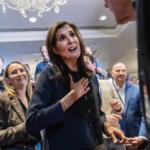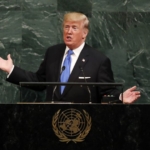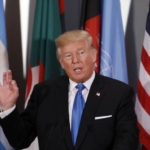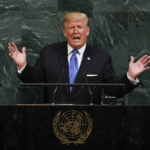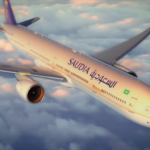Yesterday Donald Trump opened his first international trip as US President. The busy agenda includes The Vatican, Israel and Brussels, for a nine-day tour around Europe and the Middle East. He chose Saudi Arabia for the inaugural meeting, a well-calculated choice that clearly marks the new administration’s approach toward one of the US historic and most strategic allies.
This international trip is a crucial political moment, especially for a newly elected president. Especially for a newly elected president that is already having political scandals back home. Indeed, it represents an excellent opportunity to meet several heads of states and government representatives all over the world, as well as a key moment to strengthen US alliances and to give a new breath to the nation posture in the international political arena.
The choice of Saudi Arabia as the first meeting is, therefore, a first quite unequivocal sign of the path President Trump wants to undertake. Saudi Arabia has always been one of the most important US allies in the region and the two countries share economic, political and strategic interests. Relations have been very close and friendly, showing a strong mutual understanding and the willingness to cooperate in several areas. However, under Obama’s administration, the happy marriage went through a very hard time, often referred by Saudi representatives as the worst in the US-Saudi history. Trump’s decision seems to be a smart move to show Saudi Arabia and the entire world the administration intention to go back to the strong and loyal relationship between the countries, after the challenging times of Mr Obama.
Several reasons stand behind this strategic choice, which can be read within the US-Saudi Arabia partnership’s framework, but also within the broader context of the US strategy in the Middle East.
Regarding US-Saudi relations, economic and security interests are the main issues on the table. Deals on weapons and defence systems are back on track after Obama stopped selling arms to the monarchy, worried about its possible influence –better said military support- in Yemen’s war (Saudi Arabia leads an international coalition supporting the government against the Houthi rebels). Trump seems not be sharing these concerns: the deals include, indeed, a Terminal High Altitude Area Defence (THAAD) missile defence system, a C2BMC software system for battle command and control and communications as well as a package of satellite capabilities, all provided by Lockheed. Under consideration also combat vehicles made by BAE Systems PLC, including the Bradley Fighting Vehicle and M109 artillery vehicle. Contrary to the previous administration, the US appears to be supporting a more interventionist Saudi role in the region. Along the commercial agreements, Washington and Riyadh are also enhancing best practices in maritime, aviation and border security.
Looking at the broader US strategy in the Middle East, the visit in Saudi Arabia makes even more sense.
Since taking office, fighting the Islamic State (ISIS) has been Trump’s top national security priority. As the president made clear, ISIS -and terrorism in general- is not a regional problem, but one that affects the all international community, harming, therefore, also US interests back home and abroad. Similar consideration for the security conditions in the Middle East, which are essential to protect US economic and strategic interests in the region. These reasons made Trump reconsidering the US role in the Middle East. If Obama tried to step back and put some distance between the US politics and Middle Eastern affairs, giving the impression that the American power was turning the back to its allies in the region, Mr Trump has clearly shown different intentions.
The US is to re-take its posture in the Middle East, perhaps that security guarantor role that used to play in the past, willing to bring safety and stability in the region and, therefore, at the global level. Hence, the strong position taken by Iran’s antagonist behaviour and the attempt to reassure the US allies in the Gulf can be easily related to this new approach.
So, what does that mean in terms of regional security and international political games?
– With the US support in fighting terrorism, the Gulf monarchies will be able to strengthen their positions against the Islamic State and terrorist groups. ISIS and other terrorist groups, indeed, have been trying to destabilise the Gulf monarchies. On the one hand, they took advantages of religious minorities and social differences in the countries. On the other, they benefited from an inconsistent European strategy in the region and a US administration probably more focused on domestic authoritarian issues and human rights records in its ISIS-fight partners than on the actual final goal. Trump seems to be setting priorities and boundaries: ISIS and terrorism come first; democracy and authoritarian tendency are a domestic issue that the US does not have to deal with now. To fight ISIS we need stable countries: simple as that. As the Secretary of State Rex Tillerson said “When everything is a priority, nothing is a priority. We must continue to keep our focus on the most urgent matter at hand.”
– A new challenging US-Iran relation. If Obama’s era will be remembered in all history books for the multilateral nuclear deal with the Islamic Republic, Trump administration will unlikely follow the same path. As initial steps, Trump tightened sanctions against Iran, thus sending the message that time had changed and Iran must better behave. Several press statements denounced Iran’s antagonistic behaviour and defined the country as a plague for the Middle East and US interests there. No surprise, then, if engagement and accommodation of Obama’s office will be replaced by confrontation and hostility, a move very welcomed by the Arab countries.
– By signing new weapon deals with Saudi Arabia, the US indirectly supports the Saudi-led coalition in Yemen, a conflict that involves Iran too. The Islamic Republic, indeed, militarily support the Houthi rebels against the government. As mentioned above, Iran is considered a real threat to Middle East stability.
– A stronger commitment to the Middle East stability cannot overlook the Israeli-Palestinian conflict. Trump is pursuing peace talks between Israel and Palestine to set a lasting agreement. The two-state solution has been a core pillar of US foreign policies for decades -an independent state of Palestine in West Bank and Gaza in return for Israel’s safety and security. However, Trump affirms to be also opened to a one-state solution, where Israel will be the only state and Palestinians will either become citizens of Israel or else live under permanent occupation without voting rights. As the president said, “I’m happy with the one they [Israelis and Palestinians] like the best”. Not easy to understand, though, how Palestinians could like the second one.
– Trump’s visit to Saudi Arabia, a Muslim country but also the home of the most significant Islamic religious sites, can be read as a strategic move to achieve the role the US would like to play in the Middle East. With the implementation of the immigration policies in the States and several statements against the Muslims, President Trump has attracted severe criticisms, describing him and his policies as anti-Muslim. Not the best precondition for someone that aims at playing a greater security role in the region. Hence, visiting the Saudi monarchy shows that the US and Arab Muslims can actually form a partnership and cooperate on some issues.
– At first glance, it is understandable to think that a more interventionist US role in the Middle East could upset Russia. On several capillary topics -such as Syria and Yemen- Russia and the US have quite divergent views and stand on the opposite sides of the fight. A US administration willing to play the police role in the region and -possibly- put feet on the ground is not exactly what the Kremlin would like to see. However, the scandal that has recently hit the White House- regarding Trump sharing highly classified information with the Russians-questions the real relationship between Washington and Moscow.
In conclusion, Trump’s meeting with Saudi Arabia’s leaders goes beyond the routine diplomatic visits, as it also entails powerful political messages to the Arab countries and the entire world. A new page for the US foreign policy that aims to bring the old glory and its leader role in the Middle East. It looks like the new administration is backed by a crispy and definite strategy; however, on some topics it seems like Trump is proceeding blindly, just reacting to whatever it happens. The question is: does he have a strategy in mind? The US is a very powerful nation and -willing or not- its actions have a substantial impact worldwide. Hopefully, there will be some still unrevealed aces in the hole: the last thing that the world would like to see is the US wandering around without knowing what to do. It is time to take sides, it is time to make decisions, and Trump seems to be quite confident in doing so. However, to be effective, those decisions need directions, need a strategy, a smart long term project aiming at a specific goal. Let’s hope the current US administration truly has one.
Paola Fratantoni

